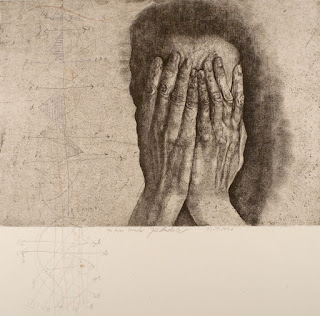A place for talking about art, social issues, and most anything else I think THAT'S INKED UP.
Friday, October 16, 2015
Jiri Anderle: The Czech Printmaker of Beautiful Evil
Jiří Anderle (b. 1936) is a Czech artist, originally from Pavlíkov, Rakovnicko. Anderle faced oppression in the making of his work, and he fought through the era of the Iron Curtain to produce a large body of prints, paintings and drawings which has received international acclaim. Fortunate for us, his work has been exhibited globally and is included in numerous museum collections.
Anderle’s evidently looked at the Old Masters, borrowing a thing or two from the excellent, detailed still lives and seductive portraits of Caravaggio. He has utilized his great drawing skills to portray portraits of young Renaissance-period women, youthful clad in elegant gowns and hair plaited with ribbons and pearls.They exude an aura of innocence and purity. Yet, there lies and undercurrent of something beyond their facade. No maiden could be so untouched, could she?
He contrasts these women with his later, more abstracted style of portraiture which is clearly influenced by Dubuffet, Klee and Bacon. Their facial and figural surfaces are butchered, nearly extinguished, yet their emotional/physical impact leaves the viewer with the feeling they have truly seen someone evil. One is reminded of the sickeningly ugly faces of Nolde and the German Expressionists who tore away the mask of civility to reveal Mankind’s truer nature. Anderle gives us a hint of that, and scrapes away the flesh of his subjects to reveal a complex interior system of hoses and pipes and chaos. We don't see the figures for the chaos of what's pouring out from their interiors.
The family portrait above looks a lot like the work of fellow printmaker Mauricio Lasansky. The faces are detail but everything else is left undone. He gives us what we need to see. Nothing more.
Throughout his work the drawn line is revered, and the polar contrasts of good and evil are presented in classically drawn faces imposed upon composed surfaces of emptiness. The portraits are virtually complete, yet he lets the faces evolve and change in a serial sort of passage of time. In contrast to the elegance of his drawn line, the edges of Anderle’s images appear to be eaten away, eroded and corroded. They break us from whatever narrative he tried to imbue upon the image, and tear us away back to the surface’s edge. They stop us from delving into the composition and make us explore the irregular edge of things, the breakup of the world. These images are indicative of the state of Man, our want to see beautiful things, but in the end they show the reality of our society’s unending need to destroy everything.
The more abstract images are harder to look at, morbid, in fact, but look we must. For they tell us about our own truer destructive nature, and foretell our own demise. Anderle’s work is not bleak or somber. It is sometimes dually ugly and inviting. Whatever Anderle chooses to depict, he invites us to look. We can’t help ourselves. It’s like trying to eat just one of your favorite mom's freshly baked chocolate chip cookies that she just took out of the oven. You can’t eat just one. You have to have more and more until you are sick to your stomach. Not trying to equate Anderle’s work with food per se, but it does compel us to look at it, ingest it, savor it, and then spit it back out. His beautifully evil work can be addictive. It should be. Take a look for yourselves, my inked up friends. Anderle makes certain there is enough for everyone's taste.
Jiri Anderle lives and works in Prague, the Czech Republic.
Facts:
1955-1961 – studied at the School of Applied Arts and the Academy of Fine Arts, in Prague.
1961-1969 - member of the Black Theatre of Prague.
1964 - Marries Milada, a fellow member of the Black Theatre company.
1968 – USA exhibition debut, works with Jacques and Anne Baruch Gallery, Chicago.
1981– awarded Grand Prix at International Biennial of Prints, Ljubljana.
1982 - exhibited at the Biennale di Venezia. Print retrospective at the National museum, Stockholm.
1995 - Retrospective at the National Gallery, Prague.
2008 - Largest USA retrospective of Anderle's prints at Cincinnati Art Museum.
2006 - awarded the Medal of Merit III.
100 - solo exhibitions throughout the world
Selected Public Collections:
Art Institute of Chicago, Chicago, Illinois, USA
Berkeley Art Museum and Pacific Film Archive, UC, Berkeley, California, USA
Bibliotheque nationale de France, Paris, France
California College of the Arts, San Francisco, California, USA
Centre Pompidou, Paris, France
Czech Museum of Fine Arts, Prague, Czech Republic
Detroit Institute of Arts, Detroit, Michigan, USA
Galleria Civica d’Arte Moderna e Contemporanea, Turin, Italy
The Jewish Museum, New York, New York, USA
Library of Congress, Washington, DC, USA
Metropolitan Museum of Art, New York, New York, USA
Musee d’Art Moderne, Brussels, Belgium
Musee des Beaux-Arts, Liege, Belgium
Musee National d’Histoire et d’Art, Luxembourg
Museum of Contemporary Art, Skopje, Macedonia
Museum of Modern Art, New York, New York, USA
Narodni galerie v Praze (The National Gallery in Prague), Czech Republic
National Gallery of Art, Washington, DC, USA
Nationalgalerie, Berlin, Germany
Nationalmuseum, Stockholm, Sweden
Slovenska narodna galeria (Slovak National Gallery), Bratislava, Slovakia
Stedelijk Museum, Amsterdam, Netherlands
Uffizi Gallery, Florence, Italy
USC Fisher Museum of Art, USC, Los Angeles, California, USA
Victoria and Albert Museum, London, England
World Print Council, San Francisco, California, USA
Labels:
Caravaggio,
Czech,
etching,
Jiri Anderle,
Old Masters,
portraits,
Prague,
still life
Subscribe to:
Post Comments (Atom)









No comments:
Post a Comment